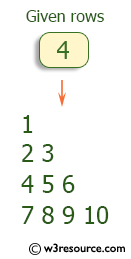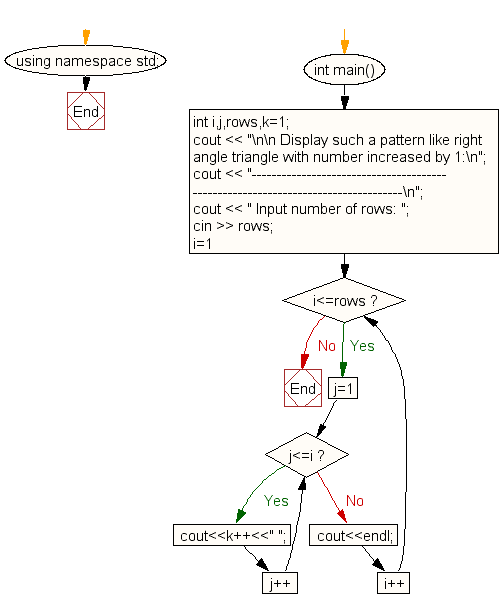C++ Exercises: Display the pattern like right angle triangle with number increased by 1
38. Right-Angle Triangle Pattern with Increasing Numbers
Write a C++ program to make such a pattern like a right angle triangle with the number increased by 1.
Visual Presentation:

Sample Solution:
C++ Code :
#include <iostream> // Include the input/output stream library
#include <string> // Include the string handling library
using namespace std; // Using standard namespace
int main() // Main function where the execution of the program starts
{
int i, j, rows, k = 1; // Declare integer variables i, j, rows, and k with k initialized to 1
// Display message asking for input
cout << "\n\n Display such a pattern like right angle triangle with number increased by 1:\n";
cout << "---------------------------------------------------------------------------------\n";
cout << " Input number of rows: ";
cin >> rows; // Read input for the number of rows from the user
// Loop to print the pattern with numbers increased by 1 in a right-angle triangle shape
for (i = 1; i <= rows; i++) // Loop for the number of rows
{
for (j = 1; j <= i; j++) // Nested loop for printing numbers in each row
{
cout << k++ << " "; // Print the value of 'k' (increased by 1) and increment 'k' afterwards
}
cout << endl; // Move to the next line after each row is printed
}
}
Sample Output:
Display such a pattern like right angle triangle with number increased by 1: --------------------------------------------------------------------------------- Input number of rows: 4 1 2 3 4 5 6 7 8 9 10
Flowchart:

For more Practice: Solve these Related Problems:
- Write a C++ program to print a right-angle triangle pattern where numbers increase sequentially across the rows.
- Write a C++ program that displays a triangle pattern such that each row starts where the previous row ended with increasing numbers.
- Write a C++ program to output a numeric triangle pattern where each row’s numbers are in continuous increasing order.
- Write a C++ program that reads an integer n and prints a triangle pattern with numbers increasing by 1 throughout the rows.
Go to:
PREV : Right-Angle Triangle Pattern with Repeated Numbers.
NEXT : Pyramid Pattern with Increasing Numbers.
C++ Code Editor:
Contribute your code and comments through Disqus.
What is the difficulty level of this exercise?
